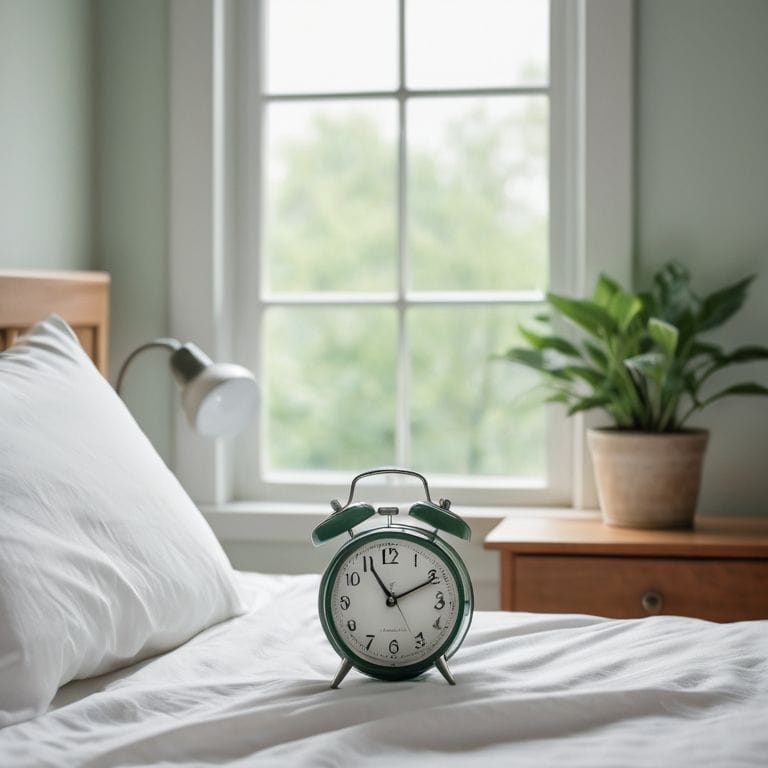I still remember the days when I’d stumble into my lab, bleary-eyed and running on fumes, wondering how to fix my sleep schedule. As a neuroscientist, I knew the importance of sleep, but like many of us, I struggled to prioritize it. The common advice to “just sleep more” or “establish a consistent sleep schedule” felt like a distant fantasy. I’d try to follow the usual tips, but they seemed to overlook the underlying complexities of our brains and bodies. It wasn’t until I delved deeper into the science of sleep that I discovered the truth: fixing your sleep schedule requires a holistic approach that addresses the intricate balance between our lifestyle, environment, and biology.
In this article, I’ll share my personal story of overcoming sleep deprivation, as well as the evidence-based strategies I’ve uncovered through my research. You’ll learn how to reset your body’s internal clock, create a sleep-conducive environment, and develop habits that promote deep, restorative sleep. I’ll cut through the noise of pseudoscience and wellness fads, giving you practical advice on how to fix your sleep schedule and start waking up feeling refreshed, renewed, and ready to take on the day. By the end of this guide, you’ll have a clear understanding of how to prioritize sleep and make it a sustainable part of your lifestyle.
Table of Contents
Guide Overview: What You'll Need

Total Time: 1 week to 10 days
Estimated Cost: $0 – $10
Difficulty Level: Easy
Tools Required
- Alarm Clock (or alarm app on smartphone)
- Journal (for tracking sleep patterns)
- Comfortable Bedding (including mattress and pillows)
Supplies & Materials
- Blackout Curtains (optional, for better sleep environment)
- White Noise Machine (optional, for improved sleep quality)
- Melatonin Supplements (optional, after consulting a doctor)
Step-by-Step Instructions
- 1. First, do this: establish a consistent wake-up time. I know, it sounds simple, but trust me, it’s the foundation of resetting your body’s clock. Set your wake-up time to the same time every day, including weekends, and try to get up at that time no matter what. This will help regulate your body’s internal clock and improve the quality of your sleep.
- 2. Next, start by gradually adjusting your sleep schedule if you’re not already sleeping at a reasonable hour. If you’re used to staying up until 2 am, trying to switch to a 10 pm bedtime immediately might be too drastic. Instead, try going to bed 15-30 minutes earlier each night until you reach your desired bedtime. This will help your body adjust to the new sleep schedule without feeling like you’re being put through a sleep deprivation experiment.
- 3. Now, it’s time to optimize your sleep environment. This means making your bedroom a sleep sanctuary. Ensure it’s dark, quiet, and at a comfortable temperature. Consider investing in blackout curtains, earplugs, or a white noise machine if necessary. And please, for the love of all things scientific, get rid of any screens in the bedroom – the blue light emission from smartphones, tablets, and computers can suppress melatonin production, making it harder to fall asleep.
- 4. Fourth, establish a pre-sleep routine that signals to your brain that it’s time to wind down. This could be as simple as reading a book, taking a warm bath, or practicing some gentle stretches. Avoid stimulating activities like exercise, playing video games, or watching exciting movies at least an hour before bedtime. The goal is to calm your mind and body, not get them revved up.
- 5. Fifth, be mindful of your diet and hydration. Avoid consuming heavy meals, caffeine, and alcohol close to bedtime, as they can disrupt your sleep patterns. A light snack or herbal tea might be okay, but be cautious not to overdo it. Also, make sure you’re staying hydrated throughout the day, but try to limit your fluid intake in the hours leading up to bedtime to minimize midnight trips to the bathroom.
- 6. Sixth, get some morning sunlight exposure as soon as possible after waking up. Natural light exposure helps regulate your circadian rhythms, which can help improve the quality of your sleep. Spend some time outside in the morning, or open your curtains to let the sunlight in. This will help your body get into a consistent sleep-wake cycle.
- 7. Finally, be patient and persistent. Fixing your sleep schedule doesn’t happen overnight (no pun intended). It can take some time for your body to adjust to the new sleep schedule, so don’t get discouraged if you don’t see immediate results. Stick to your routine, and with time, your body will start to adapt, and you’ll find yourself sleeping better and feeling more rested.
Fix Your Sleep Schedule

To further support your journey to better sleep, consider establishing a bedtime routine that signals to your brain that it’s time to wind down. This could be as simple as reading a book, practicing gentle stretches, or enjoying a warm bath. The key is to find activities that help you relax and avoid screens for at least an hour before bedtime, as the _impact of screen time on sleep_ can be significant. The blue light emitted from devices can suppress melatonin production, making it harder to fall asleep.
In addition to a bedtime routine, _morning sunlight exposure_ can also have a profound effect on your sleep patterns. By getting outside in the morning, you’re exposing yourself to natural light, which helps regulate your circadian rhythms. This can be as simple as taking a short walk or sitting by a window with natural light. Be mindful of caffeine effects on sleep patterns, as consuming it too close to bedtime can disrupt your ability to fall asleep and reduce the quality of your sleep.
As you work on resetting your sleep schedule, don’t underestimate the importance of _relaxation techniques for insomnia_. Practices like deep breathing, meditation, or yoga can help calm your mind and body, making it easier to fall asleep and stay asleep. By combining these techniques with a consistent sleep schedule and a sleep-conducive environment, you’ll be well on your way to improving the quality of your rest.
Optimizing Sleep Environment Matters
To optimize your sleep environment, consider the role of light and temperature. Darkness and a cooler room can significantly improve sleep quality. Invest in blackout curtains or blinds to block out any harsh light, and aim for a temperature between 60-67 degrees Fahrenheit. This will help regulate your body’s natural sleep-wake cycle.
A quiet environment is also essential. If you live in a noisy area, look into earplugs, white noise machines, or soundproofing solutions. By creating a sleep-conducive environment, you’ll be better equipped to establish a consistent sleep schedule and improve the overall quality of your rest.
Resetting Bodys Clock Naturally
To reset your body’s clock naturally, you need to focus on synchronizing your circadian rhythms with the 24-hour day-night cycle. This means exposing yourself to natural light during the day and darkness at night. I recommend taking a short walk outside in the morning to get some sunlight, and in the evening, dimming the lights to signal to your body that it’s time to wind down.
By doing so, you’ll be leveraging the powerful influence of light on your internal clock, regulated by a small group of cells in the brain called the suprachiasmatic nucleus. This simple yet effective approach can help your body adjust to a consistent sleep schedule, leading to improved sleep quality and overall well-being.
Reset Your Internal Clock: 5 Evidence-Based Tips to Fix Your Sleep Schedule
- Set a consistent wake-up time, even on weekends, to regulate your body’s circadian rhythms and improve the quality of your sleep
- Gradually adjust your bedtime by 15-30 minutes every few days to avoid shocking your system, allowing your body to adapt to the new sleep schedule
- Establish a relaxing bedtime routine, such as reading or meditation, to signal to your brain that it’s time to sleep, and avoid screens for at least an hour before bedtime
- Optimize your sleep environment by ensuring it’s dark, quiet, and cool, and consider investing in blackout curtains, earplugs, or a white noise machine if necessary
- Get some morning sunlight exposure to help regulate your circadian rhythms, and avoid napping close to bedtime to prevent disrupting your sleep schedule
Key Takeaways to Reset Your Sleep
Set a consistent sleep schedule and stick to it, even on weekends, to regulate your body’s internal clock and improve the quality of your sleep
Optimize your sleep environment by ensuring it is dark, quiet, and at a cool temperature, and invest in a comfortable mattress and pillows to promote better rest
Avoid exposure to screens and electronic devices at least an hour before bedtime, and try relaxation techniques like deep breathing or meditation to calm your mind and prepare your body for sleep
A Wake-Up Call
To truly fix your sleep schedule, you must first acknowledge that your body is not a machine to be hacked, but a complex system to be understood – and that means ditching the quick fixes and embracing a lifestyle that respects the ancient rhythms of your biology.
Dr. Alistair Finch
Taking Back Control of Your Sleep

To fix your sleep schedule, it’s essential to remember that small, consistent changes can add up over time. We’ve discussed the importance of resetting your body’s clock naturally and optimizing your sleep environment to improve the quality of your rest. By setting a consistent bedtime, creating a sleep-conducive environment, and avoiding screens before bedtime, you’re well on your way to developing healthy sleep habits. It’s also crucial to be patient and compassionate with yourself throughout this process, as it may take some time for your body to adjust to the new routine.
As you embark on this journey to reclaim your sleep, remember that it’s a process that requires dedication, self-care, and a willingness to let go of unhealthy habits. By prioritizing your sleep and making it a non-negotiable part of your daily routine, you’ll be amazed at the positive impact it can have on your overall well-being. So, take a deep breath, stay committed, and watch your body and mind thrive as you start getting the restful sleep you deserve.
Frequently Asked Questions
What are the most common obstacles to establishing a consistent sleep schedule and how can I overcome them?
Common obstacles to a consistent sleep schedule include irregular work hours, screen time before bed, and consuming heavy meals or caffeine too close to bedtime. To overcome these, set a realistic bedtime, establish a calming pre-sleep routine, and avoid screens for at least an hour before bed.
How long does it typically take for the body to adjust to a new sleep schedule and start seeing improvements in sleep quality?
Typically, it takes around 2-4 weeks for your body to adjust to a new sleep schedule. Be patient, as it’s a process. Research suggests that your brain needs time to recalibrate its internal clock, and consistency is key. Stick to your new schedule, and you’ll start noticing improvements in sleep quality, such as better rest and increased energy levels.
Are there any specific sleep disorders or health conditions that may require a more tailored approach to fixing a sleep schedule, and if so, how can I determine the best course of action?
Certainly, conditions like insomnia, sleep apnea, or restless leg syndrome require customized approaches. If you’re struggling with a specific sleep disorder, consult a healthcare professional to determine the best course of action – they’ll help you develop a personalized plan based on your unique needs and medical history.
